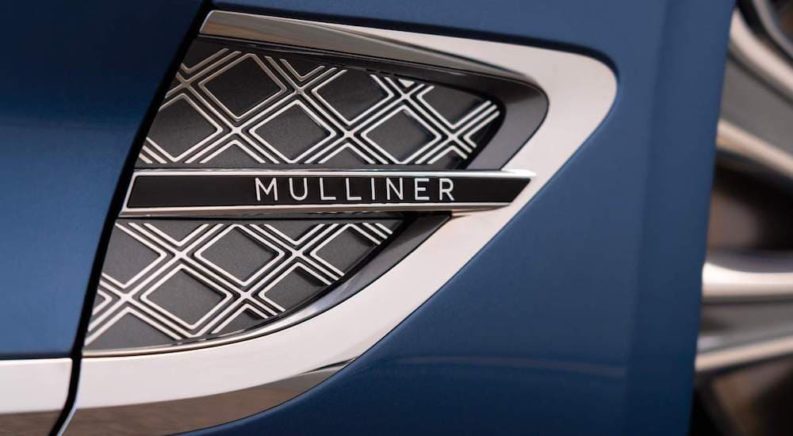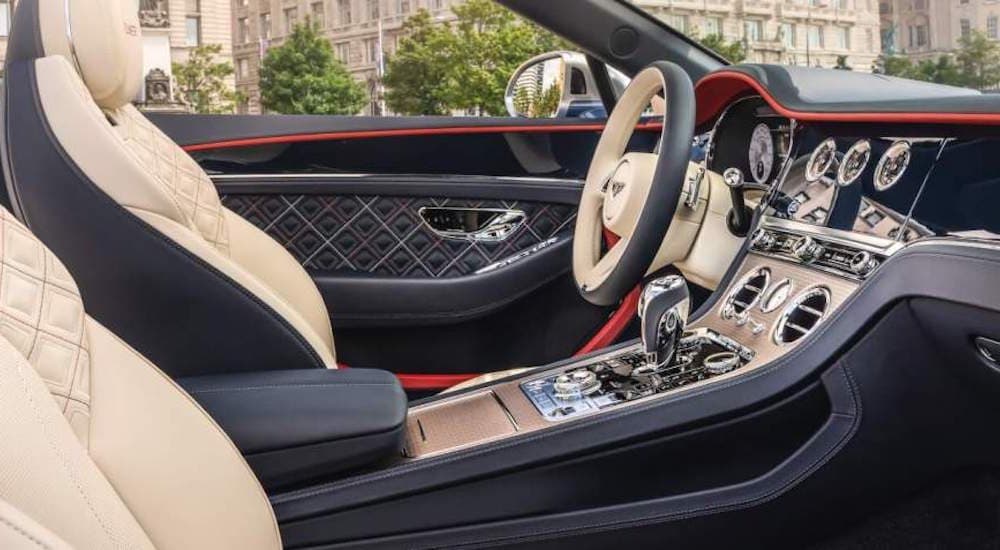As an average, everyday peasant, it’s easy for me to look at marques such as Cadillac, Lexus, and Mercedes-Benz as the pinnacle of luxury. Large, beautiful, and nigh-unobtainable with sticker prices that look like my mortgage, what I can’t attain is in my face every time I look at the news of the automotive world. Supercars might as well be on another planet; hypercars, celestial beings – but like planets and celestial beings, our collective enthusiasm for their significance borders on obsession. They represent the limits of automotive engineering and the pinnacle of design.
Or…do they? There’s another category of vehicle I haven’t mentioned, one which silently (or at least, smoothly) sails under the radar of mass-market / speed-crazed heathens such as myself. All too happy to live in the privacy of the shadow cast by brands like BMW, Lincoln, or Acura is the hyper-luxury car, making base Range Rovers look like a dollar store alternative.
The Spectrum of Performance
Not all hyper-luxury brands are created equal. Distinct from sports/supercar brands like McLaren, Ferrari, and Aston Martin – where fine interiors, top-of-the-line tech, and broad customizability are expected because of the price and prestige of the brand – hyper-luxury finds lap times to be of little concern. We’re talking about Rolls Royce, Mercedes-Benz Maybach, and Bentley. There are about 15 brands where the price of entry is a 6-digit number, and virtually all of these – from Lotus and Lambo to Bugatti and Koenigsegg – are super/hyper car brands first, luxury marques second, but those three stand out from the bunch.
These are the brands that S-Class drivers view as the unobtainable deities of the automotive world, with prices that embarrass my mortgage. In fact, when compared to their chief competitors at Rolls-Royce, Maybach models are often held back by their proximity to the S-Class. Excuse me while I go stare at my reflection and slap myself for writing something so absurd. While these two execute a ballroom dance that dominates the floor, just off to the side, with one wary eye on the marvelous couple and another on the gossiping supercar brands by the bar, is Bentley.
Bentley seems to defy explanation. Founded on the principle that there is no replacement for displacement, they thundered along a brief but torrid run of racing championships throughout the pre-war and Roaring ’20s eras before being acquired by Rolls Royce in the Great Depression. Although they essentially lost their identity for decades and sold hundreds, not thousands, of cars, it was Volkswagen who rescued them and reinjected classic Bentley DNA to the brand. Now Bentley is selling not thousands, but tens of thousands of cars.
There are only three models today, but they all follow the same theme: luxury that’s damn-near-close-enough to Rolls-Royce and enough power and speed to forget that they weigh 5000 lbs apiece. The Continental GT, with high torque and AWD, can outperform Ferraris (in the snow); the Flying Spur and Bentayga claim to be the fastest four-door sedan and SUV on Earth, respectively. They compete more closely with the luxury brands pricing above them than those below, and they’ve been competing fabulously; the result is the resurgence of the coachbuilding industry.
Like, Horse-and-Buggy Coachbuilding? Are You for Real?
100% – sort of. Mulliner was a famous name in the Napoleonic era, holding commissions to build carriages for the Royal Mail from 1760. Father Francis passed the tradition to son Robert, who recognized the need for coachbuilding expertise in the newly invented horseless carriage industry during the late 19th century (I’ll remind you that early automobiles were built and sold as engines on a chassis, with no body to speak of when they left the shop). Then it was H.J. Mulliner, who made first contact with Bentley Motors in 1923 by producing a unique two-seater body for the 3 L engine model, which was displayed at the Olympia Show in London that year. So it was that Mulliner, a name associated with coachbuilding for 160 years, began its 100-year association with what may be the finest automotive brand on Earth.
Throughout the ’20s, the Bentley Boys four consecutive Le Mans victories gained tremendous publicity for the brand, and the Great Gatsby lifestyles that these wealthy racing enthusiasts were famous for became associated with the Bentley name. H.J. Mulliner’s company earned worldwide recognition by extension thanks to their productivity, which exceeded 3 Bentley bodies/month during this era.
As manufacturing techniques and automotive technology advanced, so too did Mulliner design. In fact, of the few notable Bentleys to emerge during the Rolls-Royce era, two – which are recognized not only as transformative landmarks for Bentley but as icons of the industry as a whole – were attributed to H.J. himself: the R-Type Continental (1952’s fastest 4-seater) and the Flying Spur. The timeless designs are at the foundation of the modern Continental GT’s design language to this very day.
Bentley and Mulliner made their union official in 1959, since which time the Mulliner name has continued to be associated with exclusive limited-run production vehicles boasting a degree of personalization that defies imagination. Thanks to the incredible success that Bentley has sustained since the Recession, Mulliner has now been split into three distinct divisions within Bentley, each with its own unique missions.
The Three C’s of Coachbuilding
Collections, Classic, and Coachbuilt they’re called, and though the portfolios are somewhat thin, when one considers the recency of this expansion and what it took to build the cars that they have, the future of Mulliner looks exhilarating and exclusive indeed.
Collections
The Collections division is the most well-established as far as completed projects are concerned. Special Mulliner Limited Edition versions of standard Bentleys belong to this division, as do any of the regular Bentleys that find themselves personalized into 1-of-1 status. One example is Mulliner’s 1000th project, a purple Bentayga whose customer wanted Olive Ash veneer (making a connection to Mulsanne and Bentley’s Le Mans heritage) and a contrasting stitch color for parts of the seats and doors.
Bentley says that a Mulliner customer is limited only by their imagination and the law; the Collections division demonstrates this with every offering. Don’t believe me? Consider some of the wilder interior options they lay claim to:
1) The Mulliner Tourbillon by Breitling
Breitling, the maker of $5000 Swiss watches, has been putting clocks into Bentleys for 20 years. The Mulliner Tourbillon is a particularly extravagant option developed for the Bentayga with a mother-of-pearl face, diamond indices, and a machined block of solid 18-carat gold for the casing. Backlit to display the spinning tourbillon and illuminated by a light that can synchronize with the ambient interior lighting, the absurdly valuable timepiece is a constant display of the owner’s wealth (and the time, of course).
2) 3D Wood
I know, wood is already 3D, but hear me out. While the feature may be poorly named, the execution is nothing short of exquisite. In a nutshell – an American Walnut shell, to be specific – this veneer option for the Flying Spur’s rear door trim is a block of timber machined into a perfect wooden analog to Mulliner’s diamond-quilted leather options. Tolerances of 0.1 mm (literally, paper-thin) are applied to ensure no deviations exist, which could be detected by human senses, which is good because if the passenger is anything like me, those panels would be subject to a most persistent investigation.
3) Stone Veneers
This is just silly. Bentley is famous for the hand-crafted wooden veneers adorning most of their interiors, but this feature is just madness. These are not regular veneers that have been crafted to look as though they are stone. They are stone veneers.
How does Mulliner achieve this most unnatural task of literally bending stone to their will for the sole purpose of finishing the palatial feel of their interiors? The slate or quartzite slate that they use is “ethically and sustainably sourced from India” in several colors. Cutting edge machining technologies (see what I did there?) first divide the stone panels into sheets thinner than a millimeter, then carefully finish specific areas down to 0.01 mm thick (less than half a thousandth of an inch, and approximately the same thickness as a red blood cell). At these thicknesses, the stone can be thermo-formed much like traditional wood veneers into the beautiful shapes required for dressing a Bentley interior. Seriously, check out some pictures. I think this has to be seen to be believed. Rolls-Royce’s starry night headliner has nothing on stone veneers.
Classics
Less prolific, but surely more famous, than the Collections division is the Classics team. We can thank Jaguar (with their 2015 resurrection of the E-type) and Aston Martin (with their series of so-called “continuation” models) for starting a trend among heritage-heavy luxury labels for taking old things and making them new, again.
Mulliner’s prominent project is the Blower Continuation, fusing new car smell and a pre-war driving experience (as Car and Driver put it) by building 12 exact replicas of Sir Tim Birkin’s supercharged 4 ½ L “Blower” race car from 1929. Seriously – the surviving car was fully disassembled, with each piece scanned into a 3D model that served as the basis for making the new parts, which were formed using original molds and tooling jigs wherever possible (of course). In 1929, the 240 hp Blower was one of the fastest cars in the world. Today, it’s one of the most expensive, with each of the 12 Continuation examples selling for over $2 million. No word on if any of them can fly a la Chitty Chitty Bang Bang.
Perhaps more significant than the Blower, however, is the recreation of the only 1939 Bentley Corniche, which was lost to history due to accidents during testing and the outbreak of WWII. While the vehicle was lost, its importance was not, as it was the first Bentley to incorporate attempts at streamlining in the design. Its style is the link between earlier cabriolets and the 1952 R-Type Continental that continues to inspire today. Painstaking efforts were taken to ensure that as many original parts, tools and materials were sourced as possible, including carpet that had been hidden in storage for decades. Period-appropriate styles and materials were selected; colors, identified from descriptions, were reinvented. After all that, the completed vehicle is now a member of Bentley’s Heritage Fleet for display and adoration only.
Crafting new cars which command 7-figure price tags yet are neither supercars nor modern luxury yachts – nor particularly fast, comfortable, or even drivable – Mulliner Classics is truly the historian’s car division. There is no other purpose for their existence except to continuously honor the past with loving attention and ultimate craftsmanship. Frankly, what further justification do they need?
Coachbuilt
We’ve come to it at last. Coachbuilt is the division of Mulliner in which the old traditions are genuinely new again. Back in the day, coachbuilding was a serious business, as ownership of a bodied carriage was no small thing in the severely wealth-divided era of its prime. And though coachbuilders pivoted to bodying automobiles, the personal and unique nature of the craft became somewhat lost as automakers began to create the bodies in-house at economically accessible prices. Yet Mulliner has survived, continuing to apply their trade for the uber-wealthy, producing interiors at the absolute pinnacle of luxury and beauty all along.
They take this a step further and truly resurrect the profession of coachbuilding with this third division of the organization. While the vehicles they produce are not truly distinct ground-up creations, they are far less tethered to their platforms than those made by Collections.
1) Her Majesty the Queen’s State Limousine
Based on the Bentley Arnage, one of the most luxurious vehicles of its day, this was created to celebrate 50 years of rule for Queen Elizabeth II. Far from a reskin with a fancy badge on the roof, the design was heavily modified for accessibility and security, as well as to accommodate a royal entourage. They even used a model of Her Majesty’s height to perfectly calibrate the rear seat for her comfort.
2) The Mulsanne Grand Limousine
Bentley’s take on a stretch limo was a one-off of the Mulsanne (which had replaced the Arnage as Bentley’s ultimate luxury model in the 2010’s). With the most opulent rear seats Mulliner could muster, reflected by two new rear-facing seats in the lengthened passenger area, the car illustrates why Bentley belongs in the same crowd as Rolls-Royce and Maybach, not Aston Martin or Jaguar. Multi-zone rear-seat climate controls, electrochromic interior divider glass, veneered picnic tables, and two coolers were added to the rear as well. Though they stretched it by a full meter (roughly 39”), the entire profile was adjusted to adapt the concept of the base Mulsanne and preserve its classic lines, making it seem as if it was intended to be the world’s longest factory-built limousine from its very inception.
3) The Bacalar
The Bacalar is Coachbuilt’s introduction to the world. One of the most intensely styled Bentleys to ever leave the shop, it isn’t a sports car strictly speaking – but it looks the part more than any Bentley before it (except perhaps the Continental GT Speed). The Barchetta – a “little boat” or, in automotive terms, a roofless 2-seater with a raked wind deflector – draws inspiration from the wild EXP 100 concept, sitting wider and lower than the Continental GT on which it’s based. The wraparound cockpit creates a seamless transition from the inside to the out; everything is new, unique, and customizable. 5,000-year-old Riverwood (recovered from the Fenlands and technically sustainable, as no trees were felled by man to produce the material and only 12 Bacalars are being built) veneers the dash and doors. Every one of the 12 examples will be entirely bespoke, with Bentley CEO Adrian Hallmark meeting with the customers himself throughout the pandemic as they work through the design process.
With rear-wheel steering and the Continental GT’s 650 hp W12 engine under the hood, it’s surprisingly agile but reportedly conversation-quiet at freeway speeds and ultimately tuned for comfort. As MotorTrend put it after their test drive, it’s “a Bentley for the Roaring ’20s: the post-pandemic 2020s.”
Oh, Hello, Old Sport!
Think that’s hyperbole? Back in the 1920s, Mulliner Bentleys numbered a total of 240 vehicles. Plenty were surely owned by the men who owned the company and spent their fortune in between racing them and parking them for display during days-long parties. It was the least-accessible form of transportation on the planet and entirely the privilege of the privileged class. Today, the only thing that has changed is the technology, both under the hood and in the fabrication shop, enabling material and style applications that were unfathomable even a decade ago.
Need any more evidence that coachbuilding is back to stay and that the Roaring ’20s has been revived in full? Hallmark was justifiably concerned at the onset of the pandemic that economic downturns would turn off prestigious clients from the outlandish Bacalar. The big reveal at Geneva was canceled; the markets were in chaos. Yet he said that each of the 12 customers, who bought their cars sight unseen, had a simple answer when he asked them why they remained interested in a car so infuriatingly indulgent, something completely impractical and ludicrously expensive that was built to their own individual tastes and exacting standard. “Why not?”






